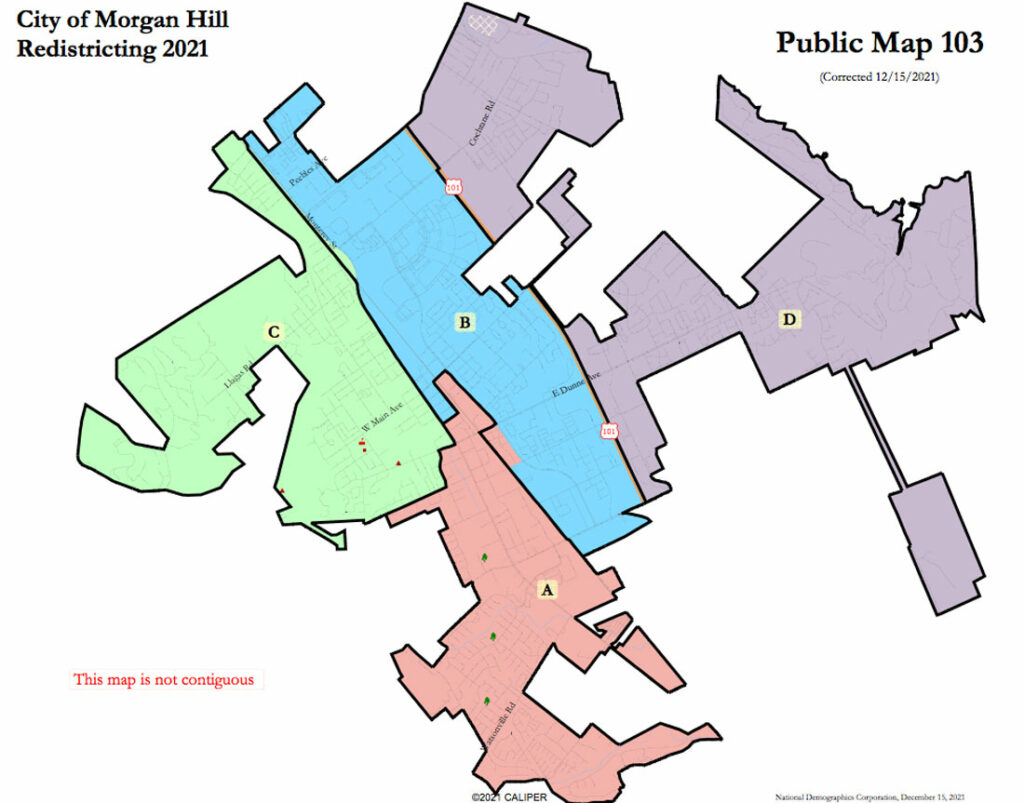Four Morgan Hill residents—including former longtime Mayor Steve Tate—are threatening to sue the city over the council’s recent approval of a redistricting map that they say is illegal under state law.
Attorney Christopher Skinnell, of the San Rafael-based Nielsen Merksamer law firm, sent a demand letter to the five-member city council March 23, urging the local officials to “comply with California’s Fair Maps Act…by reconsidering the illegal map the council adopted” on March 2.
Skinnell sent the letter on behalf of Tate, Swanee Edwards and Brian and Kathy Sullivan.
“You know how much blood, sweat and tears I have put into the City of Morgan Hill, and I’m not going to sit idly by while they intentionally violate the law,” said Tate, who served as Morgan Hill’s mayor from 2006-2018.
The council has a deadline of April 17 to adopt a final redistricting map, but voted 3-2 on March 2 to approve “Map 103” after a series of contentious discussions about whether it would hold up under the state law. Those discussions included Morgan Hill City Attorney Don Larkin warning the council numerous times that Map 103 was illegal because one of its four districts is not geographically contiguous—which is listed as the first requirement under the Fair Maps Act.
If the council declines to reconsider and adopt a different map before April 17, Skinnell and his clients “will have to consider alternative legal avenues,” including a lawsuit against the city, says the letter.
The council selected Map 103—which leaves the four council districts first established in 2017 mostly intact—out of a choice of six draft redistricting maps. The other five drafts appeared to be in compliance with the Voting Rights Act, Fair Maps Act and other state and federal redistricting requirements, according to Larkin and the city’s consultant, National Demographics Corporation.
“My hope is they’ll do the right thing and we won’t have to consider legal action,” Skinnell said.
Mayor Rich Constantine said March 28 that he couldn’t comment in detail on the legal demand because of the possible litigation that might follow. He said the council could choose to reconsider its decision on Map 103 in the coming weeks, but such a discussion has not been scheduled for an upcoming meeting.
Larkin said he is not surprised that the city received a lawsuit threat over the choice of Map 103. He said his office would be consulting with the council in the next few days to determine how to respond to the demand letter.
Skinnell’s letter states, “The illegality of Map 103 could not be more patently obvious…The Fair Maps Act specifies a particular list of criteria to be followed in municipal redistricting and the ‘order of priority’ in which those criteria should be considered. The top criteria, of course—based as they are on supreme federal law—are compliance with the equal population requirements of the Fourteenth Amendment and with the federal Voting Rights Act.
“Assuming those two criteria are met, however, the foremost criterion specified by the Act is that ‘[t]o the extent practicable, council districts shall be geographically contiguous’…” the letter continues. “Indisputably—as the city’s demographic consultants explicitly advised the council—District D is geographically non-contiguous.”
Map 103’s District D, which covers the east side of Morgan Hill, consists of two regions that are separated by a patch of unincorporated county land.

Cities with elective council districts—as well as other government bodies—are required by state and federal law to review their boundaries every 10 years based on changes in population and demographics presented in the U.S. Census.
Under the council’s elective district system, four city council members are elected by voters within each district. The city’s mayor is still elected at large by voters throughout the city.
The state’s Fair Maps Act was adopted after the council first established council districts in 2017, when attorneys threatened a VRA lawsuit in order to ensure the city’s minority population was adequately represented on the five-person dais.
The March 23 letter from Skinnell also details his objection to arguments made by members of the public and other council members, leading up to the March 2 vote, justifying the choice of Map 103 despite official warnings that it was illegal. Specifically, Morgan Hill attorney Armando Benavides argued that the phrase “to the extent practicable” gives the council some discretion on the geographic contiguity priority.
Skinnell’s letter counters, “The phrase ‘to the extent practicable’ does not, however, permit the Council to ignore contiguity in favor of a lower-ranked criterion; to conclude otherwise entirely defeats the purpose of prescribing the order of priority in the first instance.”
The letter also points out Map 103’s supporters’ shifting identification of “communities of interest,” which is listed as a lower priority in the state law’s redistricting requirements.
“Initially, this community of interest was identified as Latino voters, but drawing a district based ‘predominantly’ on this racial consideration, when not required by the Voting Rights Act, constitutes unconstitutional gerrymandering,” Skinnell wrote in the letter. “The supporters thereafter shifted gears to try to identify the purported community of interest in less explicitly racial terms, such as ‘renters.’ Factually speaking, this recharacterization is highly dubious, suggesting that it is pretextual. For one thing, the members of the public suggesting this community of interest did not identify any geographic location for this community of renters other than simply the District they sought. Moreover, District D has the lowest proportion of renters of any District in Map 103.”
Council member Yvonne Martinez Beltran was a staunch advocate for Map 103 during council discussions on redistricting. She represents District B on Map 103, and her district would have been broken up by other draft maps that were under consideration.
Martinez Beltran, Constantine and Council member Rene Spring voted in favor of Map 103 at the March 2 meeting.








